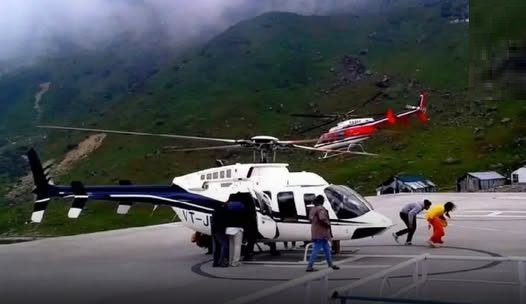A tragic helicopter crash occurred this morning near Kedarnath Dham in the Indian state of Uttarakhand, resulting in the deaths of all seven people onboard, including the pilot. The helicopter, operated by Aryan Aviation Company, was en route from Dehradun to Kedarnath, a popular pilgrimage destination, when it crashed near the Trijuginarayan area close to Gaurikunda. The accident site lies in a remote forested area, and early reports indicate that inclement weather was the primary cause of the crash.
Poor Weather Conditions Blamed
Local authorities, including District Disaster Management Officer Nandan Singh Rajwar, confirmed the incident and stated that poor visibility and bad weather conditions were likely contributors to the tragic crash. According to eyewitness accounts, including Nepali-origin women who were cutting grass in the hills near Gaurikunda, the helicopter went down suddenly in the forest above Gaurimai Kharka, a difficult-to-access mountainous terrain.
The wreckage was discovered burned, and initial visuals suggest that the helicopter caught fire either during the crash or immediately after impact. The remains of all passengers were badly charred, and among the deceased, it has been reported that a young girl was also onboard, adding to the emotional weight of the tragedy.
Helicopter Belonged to Aryan Aviation
The helicopter involved in the crash was operated by Aryan Aviation, one of the companies providing air services to the high-altitude Kedarnath region, especially during the annual pilgrimage season. Flights to Kedarnath are typically operated under strict weather advisories due to unpredictable mountain conditions, but this morning’s flight reportedly departed despite adverse meteorological signals.
The company and concerned aviation authorities are expected to launch an investigation into the crash, focusing not just on weather but also possible mechanical failures and the overall air traffic management system in the area, which sees increased activity during the pilgrimage months.
Previous Incident in the Region
This is not the first time that aviation mishaps have occurred in the Kedarnath valley. On June 7, a helicopter heading from Badasu Helipad to Kedarnath experienced technical problems shortly after takeoff. In that incident, the pilot managed to perform an emergency landing on the Rudraprayag–Gaurikund highway, averting a disaster.
Although the pilot suffered a back injury, all five passengers on board that flight survived without major harm. The contrast between that successful emergency handling and today’s tragedy has once again highlighted the risks associated with operating flights in challenging mountain weather.
Safety Concerns and Demands for Better Regulation
The tragic loss of life in today’s crash is likely to renew calls for stricter regulation and oversight of air operations to pilgrimage sites in high-risk weather zones. Kedarnath, located at an altitude of over 3,500 meters, is accessible by foot or air, and during the peak Char Dham Yatra season, hundreds of pilgrims rely on helicopter services daily.
Experts and aviation safety advocates have frequently expressed concerns over weather forecasting limitations, lack of advanced terrain warning systems, and inadequate helipad infrastructure in the region. The government and aviation authorities are expected to conduct a full safety audit of all ongoing helicopter operations in the area following this incident.
Rescue and Recovery Underway
Rescue teams were deployed promptly after locals reported the crash, and operations were carried out in difficult mountainous conditions. Recovery of bodies is being done with utmost care, and identification may take time due to the extent of burns suffered by the victims.
Officials from the Uttarakhand state government and the Directorate General of Civil Aviation (DGCA) are expected to visit the crash site and monitor the investigation closely. Meanwhile, the bereaved families of the victims are being informed, and arrangements are underway to transport the bodies once identification is complete.
This tragic event has sent shockwaves across the region, especially among those associated with the pilgrimage and aviation sectors. The incident serves as a somber reminder of the risks posed by flying in rugged mountainous terrains, particularly when weather conditions are not favorable. Authorities are under pressure to ensure that such tragedies are prevented in the future through stricter protocols and real-time weather monitoring systems.






